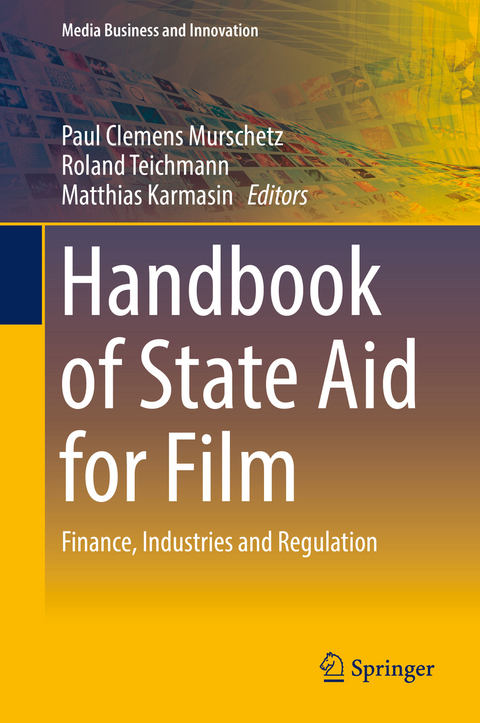
Handbook of State Aid for Film
Springer International Publishing (Verlag)
978-3-319-71714-2 (ISBN)
Paul Clemens Murschetz is Professor at Berlin University of Digital Sciences. He has been visiting senior lecturer for the University of Westminster's School of Media, Arts and Design (Department of Journalism and Mass Communication) and W2-Professor at CBS-Cologne Business School GmbH. Paul holds an MA and PhD. in management from the Vienna University of Economics and Business Studies (1989/1992), an MSc. in media and communication studies from the London School of Economics and Political Science (1996), and a Habilitation from the Alpen-Adria-Universität Klagenfurt, Austria. Roland Teichmann, LLM, is CEO of the Austrian Film Institute since 2004. Roland began his career in the Federal Economic Chamber. In 2001 he became general manager of the Association of the Audiovisual and Film Industry. Since then, he has held several leadership positions: board member of the Austrian Film Commission, advisory board member of the Association of Austrian Film Producers (aafp), Austrian representative of the International Producers Association (FIAPF), representative for Austria at EFAD (European Film Agency Directors), chairman of the advisory board of the Television Film Fund managed by the Austrian communication regulatory authority RTR and member of the European Film Academy (EFA). Roland is also national representative for Austria at Eurimages and used to teach film funding and financing at the University of Music and Performing Arts Vienna. Matthias Karmasin is full Professor and Chair for the Department of Media and Communication Studies at the Alpen-Adria University Klagenfurt in Austria. Further, he is corresponding member of the philosophic-historic class of the Austrian Academy of Sciences (ÖAW) and Director of the Institute for Comparative Media and Communication Studies aligned to it. His research focuses on media accountability, media ethics, media management, political communication, and communication theory. He is editor and co-author of 30 books and more than 100 scientific research articles.
Chapter 1: Why Study State Aid for Film? A First Clarification.- Chapter 2: Introducing the Book's Topics.- Part I: Exploring Scholarly Themes.- Chapter 3: The Economics of Film Financing: An Introduction.- Chapter 4: Private Equity Finance: The Role of Private Investors in the European Film Market.- Chapter 5: Film Governance in the EU: Caught in a Loop?.- Chapter 6: Governance, Public Interest, and Public Film Funding: Discussing a new Theoretical Framework.- Chapter 7: State Subsidies to Film and their Effects at the Box Office: Theorizing and Measuring Why Some Genres do Better than Others.- Chapter 8: How Film Financing Shapes Project Strategy: Applying Organizational Economics to a Case Study in Norway.- Chapter 9: How Hollywood Applies Industrial Strategies to Counter Market Uncertainty: The Issues of Financing and Exhibition.- Part II: AnalysingCurrent Practices.- Chapter 10: Public Funding for Film and other Audio-visual Works in Europe: Key Industry Statistics 2010 - 2014.- Chapter 11: The European Commission's Approach to Film Funding: Striking a Difficult Balance.- Chapter 12: Supporting Film Distribution across Europe: Why is Overcoming National Barriers so Difficult?.- Chapter 13: Film Funding Law in the European Union: Discussing the Rationale and Reviewing the Practice.- chapter 14: Public Film Funding in Australia: Recent History and Empirical Analysis.- Chapter 15: Exploring the Ecosystem and Principles of Austria's Film Subsidy Schemes: Is Austria A "Best-Practice" Model for a Successful Film Policy?.- Chapter 16: Film Subsidies, History and the "Economization of Culture" in Austria: An Expert Interview.- Chapter 17: Public Film Funding under a "Federalist Policy Paradigm": A Synoptic Analysis of State Aid for Film in Germany.- Chapter 18: France's Protected and Subsidized Film Industry: Is the Subsidy Scheme living up to its Promises?.- Chapter 19: Government Failure: The Ineffectiveness of Italian State Subsidies to Film.- Chapter 20: Evaluating the Effects of Protectionism on the Film Industry: A Case Study Analysis of Korea.- Chapter 21: Diversifying Public Film Funding Policies across Regions: The Case of Latin America.- chapter 22 Feature Film Funding between National and International Priorities: How does New Zealand Bridge the Gap?.- Chapter 23: Regulating the Mandatory Participation of TV Networks in Financing the Movie Industry: The Case of Spain.- Chapter 24: Public Film Policy and the Rise of Economic Principles: The Case of Switzerland.- Chapter 25: Film Funding in the United Kingdom: The "Corporate Welfare System" and its Discontents.- Chapter 26: Beyond the "Studio System": Public Support for Films in the United States.- Chapter 27: Evidencing the Economics of Film Festival Funding: Do Government Subsidies Help?.- Part III - Predicting Future Directions.- Chapter 28: Where are the Women Directors? Gender Equality for Directors in the European Film Industry.- Chapter 29: "Avant-Garde Film" Goes Digital Video:How does the United States Fund Digital Video Art and Experimental Filmmaking?.- Chapter 30: Movie Analytics and the Future of Film Finance: Are Oscars and Box Office Revenue Predictable?.- Chapter 31: An Irish Film Industry or a Film Industry in Ireland? The Paradoxes of Film Tax Incentives.- Chapter 32: Tax Incentive Schemes for Film Production: A Pivotal Tool of Film Policy?.- Chapter 33: Film Financing in the Era of "Connected TV": How do "Legacy" Broadcasters Respond to Market Changes?.- Chapter 34: Crowd-funding Movies: A Business Model Analysis from Strategic Management Studies.
| Erscheinungsdatum | 20.04.2018 |
|---|---|
| Reihe/Serie | Media Business and Innovation |
| Zusatzinfo | XXX, 666 p. 76 illus., 59 illus. in color. |
| Verlagsort | Cham |
| Sprache | englisch |
| Maße | 155 x 235 mm |
| Gewicht | 1192 g |
| Themenwelt | Sozialwissenschaften ► Kommunikation / Medien ► Journalistik |
| Wirtschaft ► Betriebswirtschaft / Management ► Marketing / Vertrieb | |
| Schlagworte | audiovisual services • Digital transformation • European Film Industry • Film Finance • film industry • Media industry • Media research • Public Funding for Films • Public Subsidies • Subsidies for Film |
| ISBN-10 | 3-319-71714-6 / 3319717146 |
| ISBN-13 | 978-3-319-71714-2 / 9783319717142 |
| Zustand | Neuware |
| Haben Sie eine Frage zum Produkt? |
aus dem Bereich


